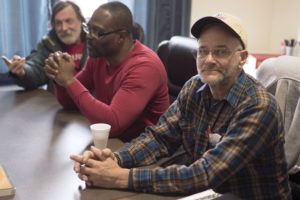A look inside Joseph House’s new Cognitive Behavioral Therapy (CBT) program
The therapy and recovery services we offer at Joseph House are tailored for a client’s individual journey and needs. To expand what we can offer our clients in their personal paths to recovery to healthy, full lives, our clinicians recently completed training in Truthought/Cognitive Behavioral Therapy (CBT).
Alicia Harter, associate director of Joseph House, shares details about the Truthought/CBT program and how it fits into Joseph House’s overall recovery and therapy services.
What is Truthought/Cognitive Behavior Therapy?

The principles of cognitive behavioral therapy can be implemented in one-on-one and group counseling sessions alike.
CBT is a therapeutic treatment that assists patients in understanding the thoughts and feelings that influence behaviors. CBT is commonly used to treat a wide range of disorders, to include phobias, addictions, depression and anxiety.
Through one-on-one and in group settings, we will be able to help clients break down, identify and understand what thoughts lead to what behaviors. Over time, we equip them with the skills to think differently and, therefore, behave differently.
Truthought is the curriculum provider through which our clinicians learned and will practice the CBT approach. The curriculum details the thinking barriers humans use that lead to negative behavior, as well as the tactics for positive thinking that lead to healthy behaviors.
How did the staff discover that there was a need for this approach at Joseph House?
We are always evaluating and implementing different approaches that can benefit our clients. One of our newer clinicians had used the Truthought/CBT approach in a previous role similar to the work we do at Joseph House. After some research, we realized it aligned with much of what our clinicians already practice. It was a good fit to formally include the program in our services.
How will CBT work with a client?
We anticipate that CBT will be effective because it is all about the here and now. For those who are in counseling for addiction, typically it is not effective to talk about past trauma or early life, as the thinking and behaviors the client believes and practices are often urgent or embedded in their current life situation.
For example, a client may know that he’s doing something he’s not supposed to be doing. The negative thinking that can perpetuate that behavior could be, “I don’t want to be a snitch,” or “I don’t want to get into trouble.” In counseling sessions, we pare that sequence of thoughts down so the client can identify and call out what thinking barrier he might be using in a certain moment. That helps us work together to correct that thought pattern, leading to healthy behavior.
We also can address it backward, starting with an action and tracing it to the initial thought. An example action may be someone picking up the phone to contact a drug dealer. We can work backward in the sequence to identify the trigger, such as feeling stressed or overwhelmed.
The CBT approach also helps with what we call the “land of absolutes.” These are the “always” and “never” phrases that a client may think, and therefore, believe about himself and then act on. A client may feel like he’ll “always” be an addict. Or that he has “never” felt like he’s belonged. We can help the client identify what thinking barrier or negative thinking technique is the root of that feeling, and help him learn a new thought pattern so he does not engage in a destructive behavior.
What’s next?
We are rolling out the program to clients in April. It will start in a group session where all counselors will be present with clients. They will then identify a group purpose, something done in group therapy in which everyone makes a promise to himself and each other. It serves as the creed, or common ground, for that group as they progress through counseling.
We plan to introduce CBT to inpatient clients, and extend its principles as clients advance into outpatient treatment.